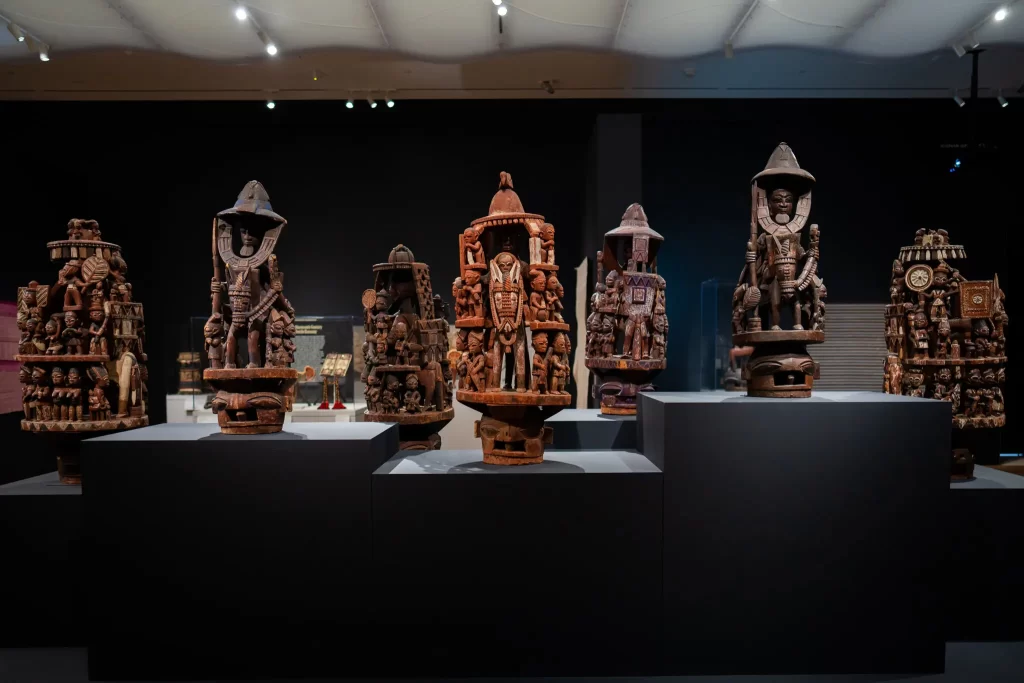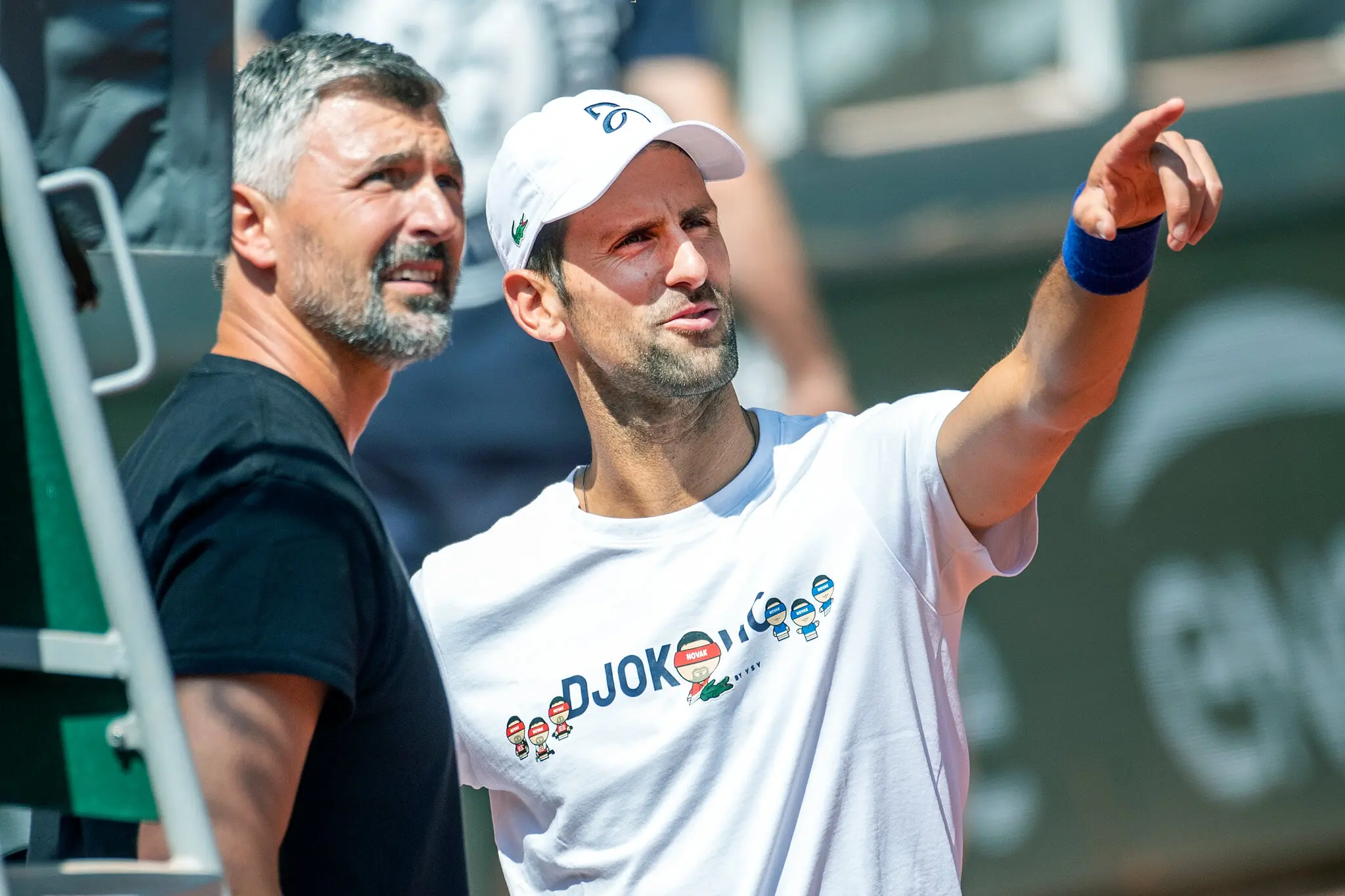
NEW HAVEN, Conn. — There’s a mountain range rising in the middle of Yale University Art Gallery, with populations of cliff dwellers circling its heights. Among the inhabitants are stoical farmers, gun-toting soldiers, singers and drummers, mothers with babies, and kids waving flags. Equestrian beauties, male and female, loom large. Leopards and antelopes roam the scene. Carved in wood, it’s a dizzying panorama, fantastic but realistic And every detail, in many cases, is the work of a single artist, Moshood Olusomo Bamigboye.
Who?
No worries if you don’t know the name. Not knowing the names of African artists, even the assumption that they didn’t have or use names, has been a Western tradition, at least till the recent sweep of contemporary artists from Africa onto the global auction stage.
Nearly 40 years ago, when the first big survey of contemporary African art opened in New York at what was then the Center for African Art, it included a selection of photographs from Mali, Togo and Ivory Coast, each picture attributed to an “unknown photographer.” Several of the entries were, in fact, by the great Malian studio portraitist Seydou Keïta (circa 1921-2001), whose authorship would be recognized and acknowledged only after the show opened, though he had been celebrated in his home city of Bamako for decades.
Bamigboye’s reputation had even greater weight and reach in Nigeria, where he was born around 1885 to a Yoruba family in Kajola in present-day Kwara State. Although he was expected to follow his father’s path into farming, his talent at woodcarving was noted early and encouraged. Carving was a profession that carried prestige, particularly the kind of work he came to specialize in: ritual imagery associated with religion and civic rule.

The Nigerian artist Moshood Oluṣọmọ Bamigboye (ca. 1885–1975) holding a portrait bust, Ilfa, Kwara State, Nigeria, ca. 1940. University of Birmingham, United Kingdom
And with 30 pieces, large and small — every known major surviving work by the artist according to the Yale Gallery — the exhibition “Bamigboye: A Master Sculptor of the Yoruba Tradition” amounts to an unusually comprehensive career retrospective, mapping his path from the 1920s, when he opened his studio, to his death in 1975.
A dynamic career it was, interweaving art, religion and politics. From the 19th century onward, the part of present-day Nigeria that falls into the region called Yorubaland, was wracked by territorial conflict, first under Islamic dominion, then British control. And the mix of Indigenous religions with Islam and evangelical Christianity was a volatile one, equally destructive and fruitful, and it surely inspired the combined images of militancy and spirituality in Bamigboye’s art. (He steadfastly held to Yoruba devotion, but in 1960 converted to Islam, taking the name Moshood.)
Organized by James Green, associate curator of African art at the Yale Gallery, the exhibition places us deep in the context of Bamigboye’s social culture. We see sculptures by near-contemporary Yoruba carvers like Dadaolomo, Akiyode of Abeokuta, and Areo-ogun-yan-na, whom he regarded as inspirations and rivals. And there are types of ritual objects — divination instruments, ceremonial staffs — on which Bamigboye would put his imaginative stamp. (In addition to running an art studio, he multitasked as a priest in a divination cult, an herbalist healer and, for the last dozen years of his life, the ruler of Kajola.)

Beaded crowns created in an unidentified crown-making workshop during Bamigboye’s time. Christopher Capozziello for The New York Times

A ceremonial robe by an unknown artist around the same period that Bamigboye was working. Christopher Capozziello for The New York Times
The show also gives a sense of the material luxe of the Yoruba world at the time, with examples of elaborate beadwork and of Islamic-influenced woven fabrics from which Bamigboye adapted geometric patterning for his carved work. And that work, which exists in some indefinable terrain between off-the-rack categories like “traditional” and “modern,” is truly magnetic.
On the one hand, the sculptural conventions attached to ritual art that he inherited and adhered to were considered sacrosanct, “a gift from God,” as he put it. Aesthetic value and spiritual efficacy were codependent. This dependency dictated a phased approach to the act of carving itself, from the roughing out of initial forms in the block of wood to the close detailing of the final product.
Each stage required the use of separate tools. And courtesy of a generous loan from the Nigerian National Museum in Lagos, —— one of more than a dozen in the show — we can see tools that Bamigboye actually used: two slim-bladed knives and a scraper, the handle of each ending in a finial carved, as if to conjure guiding spirits, in the shape of a human head.

Some of the tools Bamigboye used: two carving knives on left with finials in the shape of a woman’s head, and the scraper at right, in the shape of a man’s head. Christopher Capozziello for The New York Times
Most important, of course, is that we have the astonishing art these tools produced, work that defined mastery as an exercise of formal skill so virtuosic that it becomes its own form of radical invention. We see this invention fully and spectacularly developed in the several mountainous sculptures grouped together on high plinths in the center of the show, each designed as a sky-reaching mask to be worn — impossibly, one would think — by an individual performer in an annual Yoruba harvest festival called Epa.
All the masks have, as a base, a squat carved helmet, with eye holes front and back, to be fitted over a performer’s head, presumably with enough cushioning to make bearable the weight of the superstructure above. (Masks can measure up to 5 feet in height and weigh as much as 80 pounds.) In each case, the crowning feature is an openwork ensemble, cut from a single block of wood, dominated by a large male figure. A military leader or ruler, he wears a tasseled hat, rides a caparisoned mount, and is accompanied by dozens of smaller figures, a sculptural demographic of Kajola’s citizenry.
They encircle their ruler, but face outward, as if both protecting him and broadcasting confidence in his protective power. Bamigboye has carefully outlined the almond-shaped eyes of the figures — a signature touch in his art — with white paint that makes their collective gaze feel alert but calm. The result is a vision of Yorubaland life as a state of harmonic tension, disciplined joy.

Detail of a mask created by Bamigboye for an Epa festival with a superstructure depicting a ruler. Christopher Capozziello for The New York Times

Detail of a Bamigboye mask with a superstructure depicting a war general. Christopher Capozziello for The New York Times
To many of these tour-de-force sculptures, which are among the largest single-piece carved masks known in Africa, Bamigboye gave the generic title of “Atofojowo,” meaning “you can look at it for a whole day,” which is probably true, and you’d still find surprises. In a catalog essay, the art historian Will Rea delivers an even broader superlative, calling Bamigboye one of the “most important known artists of Africa.”
This is also true, though “known” is an important qualifier.
There are several photographs of Bamigboye himself in the show, most taken in middle and old age, and they suggest a man who, comfortable with his own charisma, had an appetite for stardom and had that appetite satisfied. The citizens of Kajola showered him with honors. His family — 12 wives and 26 children — seems to have adored him. And, a born networker, he benefited mightily from European rule.
His colonial overlords hired him to teach carving in a local school they’d created. They bought art from him, and encouraged him to study modern European styles and themes, which he did. In the show we find him turning the design for a divination board into a tea tray, and carving a portrait of a British official dressed in conspicuously snazzy Yoruba slippers and a pith helmet.
His various patrons shipped work home to the U.K. (Several sculptures appeared in a 1938 trophy display called the Empire Exhibition in Glasgow.) They even tried to persuade him to travel to England. (Untrusting, he refused.) And thanks to this supportive network, the anthropologist William Buller Fagg among them, his name stayed attached to everything he did.

Bamigboye’s portrait of Kenneth A. Robertson (“European on a Chair”), Kajla, Kwara State, Nigeria, circa 1930–45. The Trustees of the British Museum
But many other African artists who worked at the same time, and similarly bridged “traditional” and “modern” categories, continue to have profile problems outside of Africa, which is to say they remain unnamed, and so unstudied.
There have been a few exceptions. In 1980, Susan Vogel organized a solo show called “The Buli Master: An African Artist of the 19th Century” at the Metropolitan Museum of Art. In 1998, Roslyn A. Walker did the same in “Olowe of Ise: A Yoruba Sculptor to Kings” at the National Museum of African Art, Smithsonian Institution, throwing a spotlight on one of Bamigboye’s older near-contemporaries. (The Olowe exhibition catalog was the first full-length scholarly publication ever devoted to a single “traditional” African artist; Yale’s Bamigboye catalog now joins it.)
Even if, as some scholars assert, the concern with determining solo authorship in African art is merely a Western obsession, geared to museums and markets, we are long overdue in giving the careers of Africa’s great artists the monographic attention we lavish on their global counterparts.
To do so will require cooperation between continents and cultures. On the occasion of the Bamigboye show, Yale University Art Gallery and the university’s Institute for the Preservation of Cultural Heritage have partnered with Nigeria’s National Commission for Museums and Monuments on a conservation training initiative, with the aim of creating an ongoing collaboration among the institutions, evident in the presence of the loans from Lagos in New Haven.
Maybe if the restitution movement, now in bud, can truly flower, exchanging resources rather than hoarding them, as the West has done, can become a new two-way norm, and Africa’s great artists can claim their fame in the world as they have always done at home.
Bamigboye: A Master Sculptor of the Yoruba Tradition
Through Jan. 8. at Yale University Art Gallery, New Haven, Conn.; (203) 432-0600, artgallery.yale.edu.
FEATURED IMAGE: Woodcarved masks for harvest festivals can weigh up to 80 pounds, at the Yale University Art Gallery. From left foreground, a mask created by the Nigerian sculptor Moshood Olusomo Bamigboye depicting a war general; another mask attributed to Bamigboye, depicting a ruler, and a third mask, by Bamigboye, depicting a war general. Christopher Capozziello for The New York Times




